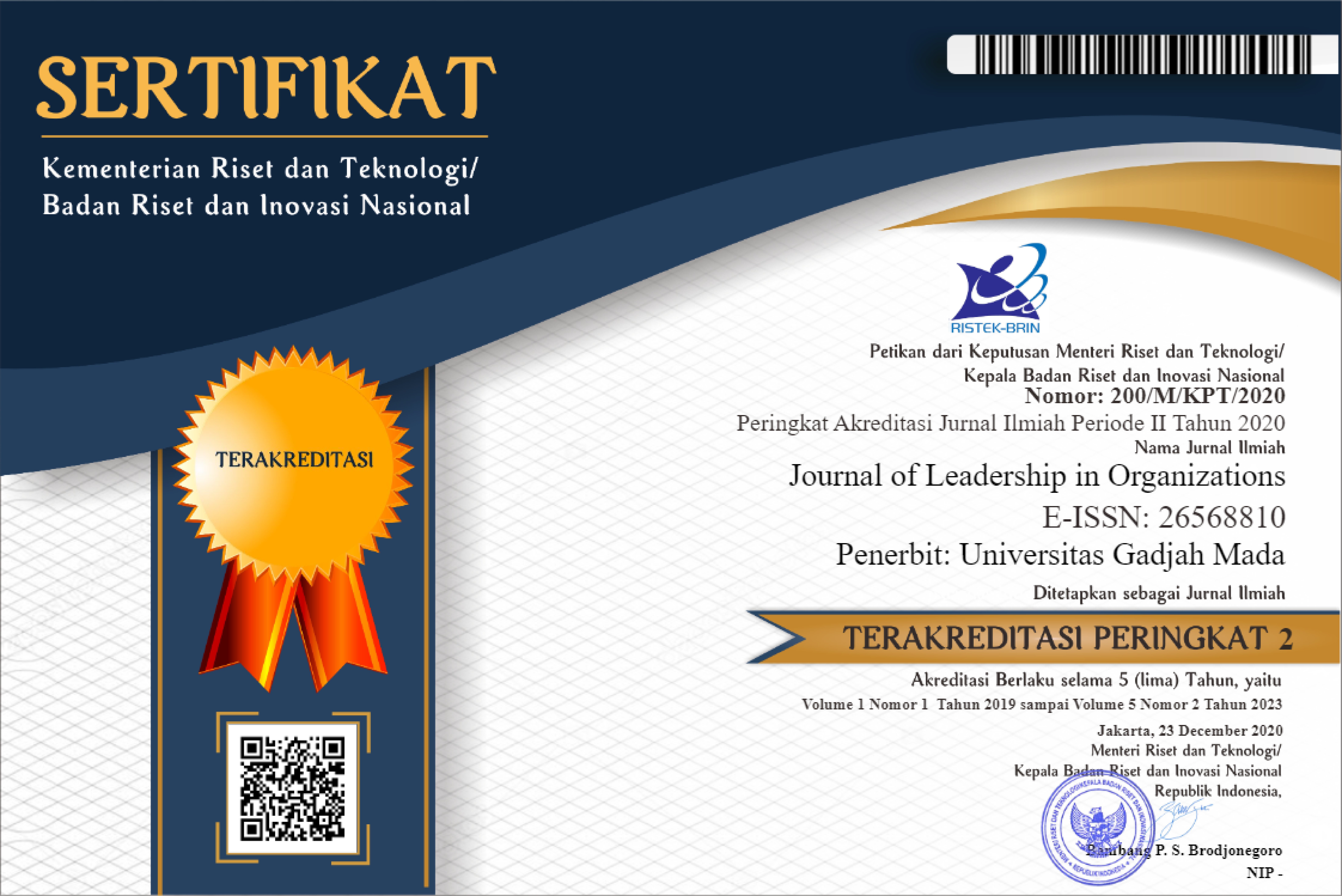LINKING LEADER MEMBER EXCHANGE AND PERSON SUPERVISOR FIT WITH EMPLOYEE PERFORMANCE: THE MEDIATING ROLE OF EMPLOYEE WORK ENGAGEMENT
Venita Putri Utami(1), Muhammad Zakiy(2*)
(1) Universitas Muhammadiyah Yogyakarta
(2) Universitas Muhammadiyah Yogyakarta
(*) Corresponding Author
Abstract
Closeness and compatibility between leaders and subordinates significantly affect the comfort of work, which results in employee performance. Through satisfaction in working, it can create employee engagement, which can contribute to improving employee performance. This study aims to determine the effect of leader-member exchange and personal supervisor fit on employee performance mediated by work engagement on Syariah Bank employees in the Special Region of Yogyakarta. The sample in this study amounted to 132 employees using purposive sampling techniques whose data collection uses cross-sectional analysis with the level of analysis of individual samples. This research uses Structural Equation Modeling (SEM) to analyze the data. The results showed that the leader-member exchange and person supervisor fit had a positive effect on work engagement, and work engagement had a positive impact on employee performance. Also, this study demonstrates that work engagement is able to mediate the positive influence of leader-member exchange and person supervisor fit on employee performance. For this reason, it can be said that work engagement is an antecedent that shapes employee performance, which is preceded by leader-member exchange and person supervisor fit.
Keywords
Full Text:
PDFReferences
Adongo, R., Kim, S. S., & Elliot, S. (2019). “Give and Take”: A Social Exchange Perspective on Festival Stakeholder Relations. Annals of Tourism Research, 75, 42-57.
Agarwal, U.A., Datta, S., Blake-Beard, & S., Bhargava, (2012). S. Linking LMX, Innovative Work Behavior and Turnover Intention (The Mediating Role of Eork Engagement). Career Development International, 17(3), 208-230.
Alessandri, G., Consiglio, C., Luthans, F., & Borgogni, L. (2018). Testing a Dynamic Model of ThemImpact of Psychological Capital on Work Engagement and Job Performance. Career Development International, 23(1), 33-47.
Anand, S., Hu, J., Vidyarthi, P., & Liden, R. C. (2018). Leader-Member Exchange as a Linking Pin in the Idiosyncratic Deals-Performance Relationship in Workgroups. The Leadership Quarterly, 29(6), 698-708.
Bakker, A. B., Tims, M., & Derks, D. (2012). Proactive Personality and Job Performance: The Role of Job Crafting and Work Engagement. Human Relations, 65(10), 1359-1378.
Bakker, A.B., & Leiter, M.P. (2010). Work Engagement: A Handbook of Essential Theory and Research. New York: Psychology Press.
Bakker, A. B., Demerouti, E., & Lieke, L. (2012). Work Engagement, Performance, and Active Learning: The role of Conscientiousness. Journal of Vocational Behavior, 80(2), 555-564.
Breevaart, K., Bakker, A.B., Demerouti, E., & Heuvel, M.V.D. (2015). Leader Member Exchange, Work Engagement, and Job Performance. Journal of Managerial Psychologi, 30(7), 754-770.
Buch, R., Kuvaas, B., & Dysvik, A. (2019). The role of other orientation in reactions to social and economic leader–member exchange relationships. Journal of Organizational Behavior, 40(3), 296-310.
Chacko, S., & Conway, N. (2019). Employee Experiences of HRM Through Daily Affective Events and Their effects on Perceived Event‐Signalled HRM System Strength, Expectancy Perceptions, and Daily Work Engagement. Human Resource Management Journal, 29(3), 433-450.
Chaurasia, S., & Shukla, A. (2014). Psychological Capital, LMX, Employee Engagement & Work Role Performance. The Indian Journal of Industrial Relations, 50(2), 342-356.
Christen, M., Iyer, G., & Soberman, D. (2006). Job Satisfaction, Job Performance, and Effort: A Reexamination Using Agency Theory. Journal of Marketing, 70(1), 137-150.
Dansereau Jr, F., Graen, G., & Haga, W. J. (1975). A Vertical Dyad Linkage Approach to Leadership within Formal Organizations: A longitudinal Investigation of The Role Making Process. Organizational Behavior and Human Performance, 13(1), 46-78.
Elnaga, A., & Imran, A. (2013). The Effect of Training on Employee Performance. European Journal of Business and Management, 5(4), 137-147.
Fan, P. (2018). Person–Organization Fit, Work–Family Balance, and Work Attitude: The Moderated Mediating Effect of Supervisor Support. Social Behavior and Personality: an International Journal, 46(6), 995-1010.
Fan, H., & Han, B. (2018). How Does Leader‐Follower Fit or Misfit in Communication Style Matter for Work Outcomes?. Social Behavior and Personality: an International Journal, 46(7), 1083-1100.
Ghozali, I. (2011). Model Persamaan Struktural dan Aplikasi dengan Program Amos 21. Semarang: Badan Penerbit Universitas Diponegoro.
Gooty, J., Thomas, J. S., Yammarino, F. J., Kim, J., & Medaugh, M. (2019). Positive and Negative Emotional Tone Convergence: An Empirical Examination of Associations with Leader and Follower LMX. The Leadership Quarterly, 30(4), 427-439.
Greenberg, J., & Baron, R.A. (2003). Behavior in Organization. United States of America: Prentice Hall.
Hair, J.F., Babin, B.J., Anderson, R.E., dan Black, W.C. (2014). Multivariate Data Analysis. United States of America: Pearson.
Hofmann, D. A., & Jones, L. M. (2005). Leadership, Collective Personality, and Performance. Journal of Applied Psychology, 90(3), 509 – 522.
Harris, C. M., Wright, P. M., & McMahan, G. C. (2019). The Emergence of Human Capital: Roles of Social Capital and Coordination that Drive Unit Performance. Human Resource Management Journal, 29(2), 162-180.
Homans, G. C. (1958). Social Behavior as Exchange. American Journal of Sociology, Vol. 63, No. 6: 597-606.
Hunter, J. E. (1986). Cognitive Ability, Cognitive Aptitudes, Job Knowledge, and Job Performance. Journal of Vocational Behavior, 29(3), 340-362.
Huston, T.L., & Levinger, G. (1978). Interpersonal Attraction and Relationships. Annual Review of Psychology, 29(1), 115-156.
Joseph, D. L., Newman, D. A., & Sin, H. P. (2011). Leader-Member Exchange (LMX) Measurement: Evidence for Consensus, Construct Breadth, and Discriminant Validity. Building Methodological Bridges. Research Methodology in Strategy and Management, 6, 89-135.
Kahn, W.A. (1990). Psychologicl Conditions of Personal Engagement and Disenggement at Work. Academy of Management Journal, 33(4), 692-724.
Kim, J., Yammarino, F. J., Dionne, S. D., Eckardt, R., Cheong, M., Tsai, C. Y., ... & Park, J. W. (2020). State-of-the-science review of leader-follower dyads research. The Leadership Quarterly, 31(1), 1 – 18.
Kim, M. S., & Koo, D. W. (2017). Linking LMX, Engagement, Innovative Behavior, and Job Performance in Hotel Employees. International Journal of Contemporary Hospitality Management, 29(12), 3044-3062.
Kristof-Brown, A.L., Zimmerman, R.D., & Johnson, E.C. (2005). Consequences of Individuals’fit at Work: A Meta-Analysis of Person-Job, Person-Organization, Person-Group, and Person-Supervisor. Personnel Psychology, 58(2), 281-342.
Lankau, M. J., Riordan, C. M., & Thomas, C. H. (2005). The Effects of Similarity and Liking in Formal Relationships between Mentors and Protégés. Journal of Vocational Behavior, 67(2), 252-265.
Li, X., Sanders, Karin., & Frenkel, S. (2012). How Leader Member Exchange, Work Engagement and HRM consistency Explain Chinese Luxury Hotel Employees’ Job Performance. International Journal of Hospitality Management, 31(4), 1059-1066.
Liden, R.C., & J.M. Maslyn. (1998). Multidimensionality of Leader Member Exchange: An Empirical Assessment through Scale Development. Journal of Management, 24(1), 43-72.
Marstand, A. F., Epitropaki, O., & Martin, R. (2018). Cross‐lagged Relations between Perceived Leader–employee Value Congruence and Leader Identification. Journal of Occupational and Organizational Psychology, 91(2), 411-420.
Maulida, U. (2018). Pengaruh Work-Family Conflict, Work Stress dan Kepuasan Kerja terhadap Kinerja Pegawai Wilayah Kerja Pengadilan Tinggi Agama NTT. Tesis. Magister Manajemen Program Pasca Sarjana Universitas Muhammadiyah Yogyakarta.
Mitchell, M. S., Greenbaum, R. L., Vogel, R. M., Mawritz, M. B., & Keating, D. J. (2019). Can You Handle the Pressure? The Effect of Performance Pressure on Stress Appraisals, Self-Regulation, and Behavior. Academy of Management Journal, 62(2), 531-552.
Nasr, M. I., El Akremi, A., & Coyle‐Shapiro, J. A. M. (2019). Synergy or Substitution? The Interactive Effects of Insiders' Fairness and Support and Organizational Socialization Tactics on Newcomer Role Clarity and Social Integration. Journal of Organizational Behavior, 40(6), 758-778.
Nunez, I., & Prieto, M. (2019). The Effect of Human Capital on Occupational Health and Safety Investment: An Empirical Analysis of SPanish Firms. Human Resource Management Journal, 29(2), 131-146.
Ogbonnaya, C. (2019). Exploring Possible Trade‐offs between Organisational Performance and Employee Well‐being: The Role of Teamwork Practices. Human Resource Management Journal, 29(3), 451-468.
Ogbonnaya, C., & Messersmith, J. (2019). Employee Performance, Well‐Being, and Differential Effects of Human Resource Management Subdimensions: Mutual Gains or Conflicting Outcomes?. Human Resource Management Journal, 29(3), 509-526.
Regts, G., Molleman, E., & van de Brake, H. J. (2019). The Impact of Leader‒Member Exchange on Follower Performance in Light of the Larger Social Network. human relations, 72(8), 1265-1291.
Robbins, S.P. (2016). Perilaku Organisasi (alih Bahasa Drs. Benjamin Molan). Edisi Bahasa Indonesia. Klaten: PT Intan Sejati.
Robbins, S.P., & T.A. Judge. (2017). Perilaku Organisasi. Edisi 16. Jakarta Selatan: Salemba Empat
Rofcanin, Y., Las Heras, M., Bosch, M. J., Wood, G., & Mughal, F. (2019). A Closer Look at the Positive Crossover Between Supervisors and Subordinates: The Role of Home and Work Engagement. Human Relations, 72(11), 1776-1804.
Rosa, N. T., & Ancok, D. (2020). The Influence of Spiritual Leadership on Affective Commitment through Calling and Membership (A Study at Zainab Mother and Child Hospital in Pekanbaru). Journal of leadership in organizations, 2(1), 18 – 29.
Salanova, M., & W.B. Schaufeli. (2008). A Cross-National Study of Work Engagement as a Mediator between Job Resources and Proactive Behaviour. The International Journal of Human Resource Management, 19(1), 116-131.
Saripudin, W., & Rosari, R. (2019). Does Spiritual Leadership Model Enhance Work Engagement? Empirical Evidence from an Islamic Hospital in Yogyakarta. Journal of Leadership in Organizations, 1(2), 112 – 133.
Schaufeli, W.B., Bakker, A.B & Salanova, M. (2006). The Measurement of Work Engagement with a Short Questionnaire. Educational and Psychological Measurement, 66(4), 701-716.
Schneider, B., Yost, A. B., Kropp, A., Kind, C., & Lam, H. (2018). Workforce Engagement: What It Is, What Drives it, and Why it Matters for Organizational Performance. Journal of Organizational Behavior, 39(4), 462-480.
Schoon, H. (2008). Person-Supervisor Fit: Implication for Organizational Stress, Organizational Commitment, and Job Satisfaction. Tesis. Clemson University
Shreya Garg, Rajib Dhar, (2017). Employee Service Innovative Behavior: The Roles of Leader-Member Exchange (LMX), Work Engagement, and Job Autonomy. International Journal of Manpower, 38(2), 242 – 258.
Sparrowe, R. T., & Liden, R. C. (1997). Process and Structure in Leader-Member Exchange. Academy of Management Review, 22(2), 522-552.
Van Vianen, A.E.M., Shen, C., & Chuang, A. (2011). Person-Organization and Person-Supervisor Fits: Employee Commitment in a Chinese Context. Journal of Organizational Behavior, 32, 906-926.
Venz, L., Pundt, A., & Sonnentag, S. (2018). What Matters for Work Engagement? A diary Study on Resources and the Benefits of Selective Optimization with Compensation for State Work Engagement. Journal of Organizational Behavior, 39(1), 26-38.
Vosloban, R. I. (2012). The Influence of the Employee's Performance on The Company's Growth-a Managerial Perspective. Procedia Economics and Finance, 3, 660-665.
Wexley, K. N., Alexander, R. A., Greenawalt, J. P., & Couch, M. A. (1980). Attitudinal Congruence and Similarity as Related to Interpersonal Evaluations in Manager-Subordinate Dyads. Academy of Management Journal, 23(2), 320-330.
Wang, T., & Zatzick, C. D. (2019). Human Capital Acquisition and Organizational Innovation: A Temporal Perspective. Academy of Management Journal, 62(1), 99-116.
Zafirovski, M. (2005). Social Exchange Theory under Scrutiny: A Positive Critique of its Economic-Behaviorits Formulations. Electronic Journal of Sociology, 2(2), 1 – 40.
Zakiy, M. (2019). To Examine Leader-Member Exchange as Moderating Variable on The Influence of Employee Psychological Uncertainty Toward Employees’ Job Satisfaction and Turnover Intention. Journal of Leadership in Organizations, 1(1), 29-47.
Zhang, J. C., Ling, W. Q., Zhang, Z. Y., & Xie, J. (2015). Organizational Commitment, Work Engagement, Person–Supervisor Fit, and Turnover Intention: A Total Effect Moderation Model. Social Behavior and Personality: an international journal, 43(10), 1657-1666.
Zhao, H., Liu, W., Li, J., & Yu, X. (2019). Leader–Member Exchange, Organizational Identification, and Knowledge Hiding: The Moderating Role of Relative Leader–Member Exchange. Journal of Organizational Behavior, 40(7), 834-848.
Zheng, X., Diaz, I., Tang, N., & Tang, K. (2014). Job Insecurity and Job Satisfaction: The interactively moderating effects of optimism and person-supervisor deep-level similarity. Career Development International, 19(4), 426-446.
Article Metrics
Refbacks
- There are currently no refbacks.
Copyright (c) 2020 Journal of Leadership in Organizations

This work is licensed under a Creative Commons Attribution-ShareAlike 4.0 International License.
| Journal of Leadership in Organizations |
| Journal of Leadership in Organizations (JLO), with registered number ISSN 2656-8829 (Print) and ISSN 2656-8810 (Online), is published by the Center for Leadership Studies, Department of Management, Faculty of Economics and Business, Universitas Gadjah Mada. The content of this website is licensed under a Creative Commons Attribution-ShareAlike 4.0 International License |
| © 2019 Journal of Leadership in Organizations | |





_logo2.png)


.png)




